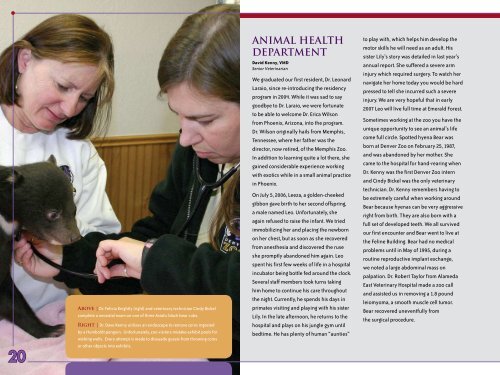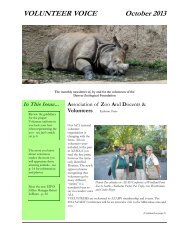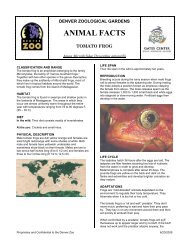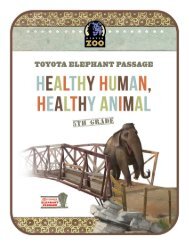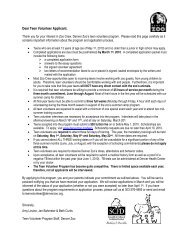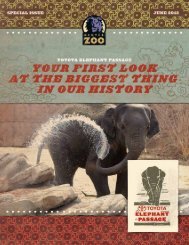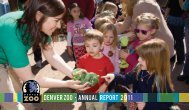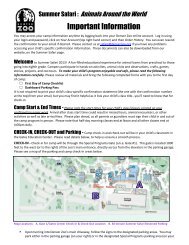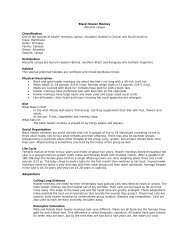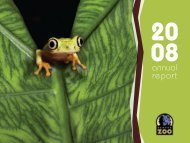20Above | Dr. Felicia Knightly (right) and veterinary technician Cindy Bickelcomplete a neonatal exam on one of three Asiatic black bear cubs.Right | Dr. Dave Kenny utilizes an endoscope to remove coins ingestedby a Humboldt penguin. Unfortunately, zoo visitors mistake exhibit pools forwishing wells. Every attempt is made to dissuade guests from throwing coinsor other objects into exhibits.ANIMAL HEALTHDEPARTMENTDavid Kenny, VMDSenior VeterinarianWe graduated our first resident, Dr. LeonardLaraio, since re-introducing the residencyprogram in 2004. While it was sad to saygoodbye to Dr. Laraio, we were fortunateto be able to welcome Dr. Erica Wilsonfrom Phoenix, Arizona, into the program.Dr. Wilson originally hails from Memphis,Tennessee, where her father was thedirector, now retired, of the Memphis <strong>Zoo</strong>.In addition to learning quite a lot there, shegained considerable experience workingwith exotics while in a small animal practicein Phoenix.On July 5, <strong>2006</strong>, Leeza, a golden-cheekedgibbon gave birth to her second offspring,a male named Leo. Unfortunately, sheagain refused to raise the infant. We triedimmobilizing her and placing the newbornon her chest, but as soon as she recoveredfrom anesthesia and discovered the ruseshe promptly abandoned him again. Leospent his first few weeks of life in a hospitalincubator being bottle fed around the clock.Several staff members took turns takinghim home to continue his care throughoutthe night. Currently, he spends his days inprimates visiting and playing with his sisterLily. In the late afternoon, he returns to thehospital and plays on his jungle gym untilbedtime. He has plenty of human “aunties”to play with, which helps him develop themotor skills he will need as an adult. Hissister Lily’s story was detailed in last year’sannual report. She suffered a severe arminjury which required surgery. To watch hernavigate her home today you would be hardpressed to tell she incurred such a severeinjury. We are very hopeful that in early2007 Leo will live full time at Emerald Forest.Sometimes working at the zoo you have theunique opportunity to see an animal’s lifecome full circle. Spotted hyena Bear wasborn at <strong>Denver</strong> <strong>Zoo</strong> on February 25, 1987,and was abandoned by her mother. Shecame to the hospital for hand-rearing whenDr. Kenny was the first <strong>Denver</strong> <strong>Zoo</strong> internand Cindy Bickel was the only veterinarytechnician. Dr. Kenny remembers having tobe extremely careful when working aroundBear because hyenas can be very aggressiveright from birth. They are also born with afull set of developed teeth. We all survivedour first encounter and Bear went to live atthe Feline Building. Bear had no medicalproblems until in May of 1995, during aroutine reproductive implant exchange,we noted a large abdominal mass onpalpation. Dr. Robert Taylor from AlamedaEast Veterinary Hospital made a zoo calland assisted us in removing a 1.8 poundleiomyoma, a smooth muscle cell tumor.Bear recovered uneventfully fromthe surgical procedure.
Over the next decade of her life, she had nosignificant medical issues until October of<strong>2006</strong>. At this time Bear stopped using her lefthind leg. She was put on an analgesic whichseemed to solve her lameness but then shedeveloped severe gastrointestinal problemsas a consequence of the medication. At thispoint, we were no longer able to offer Beara good quality of life so the hard decisionwas made to humanely euthanize her justshort of her 20th birthday. It was hard to saygoodbye to an old friend – we had grownup together.Bear activities: In <strong>2006</strong>, the hospital washeavily involved in several challenging bearimmobilizations. We had triplet Asiatic bearcubs, two males and one female, born onJanuary 16. Over the ensuing months it wasnoticed that Thai, the runt of the litter, wasbeing picked on by his siblings. It reachedthe boiling point on May 8 when Thai’smuch bigger brother severely bit his leftear and both front feet. Thai spent severalweeks in the hospital which included twocosmetic ear surgeries. We were fortunate tohave surgical support from Dr. Robert Taylorand Alameda East Veterinary Hospital. Thaiwas successfully returned to his family andwhen his hair grew back you hardly noticedhe was missing much of his left external ear.In time, he grew and thrived, no longer thevictim of his siblings roughhousing. All threecubs went to a new home in Virginia inNovember. The state of wildlife anesthesiahas reached the point where we had severalpharmacological options to assist with themove. We used a “cocktail” consisting of apotent sedative called medetomidine andthe anesthetic ketamine to immobilize thecubs for shipment. This gave us a quickimmobilization that is also quickly reversed.A week after the three bears left it wasnoticed that Soosha, an adult femalepolar bear, was having trouble rising.We immobilized Soosha with a drugcalled telazol which is a combination of aketamine-like drug and a valium-like drug.This drug also gives a quick immobilizationbut a longer duration which we needed tocomplete our diagnostics. We found shehad an arthritic left wrist and has beenstarted on a course of analgesics. A weekafter dealing with Soosha, we immobilizedan adult male polar bear, Kavek, in abreeding male swap with the Tulsa <strong>Zoo</strong>. ForKavek and the new male, Frosty, we used acombination of medetomidine and telazol.We used this combination because weneeded very heavy chemical restraint whilethe 900 pound bears were loaded and offloaded,then transported by fork lift in andout of the building. It’s very helpful to haveso many drug options that can be tailored tothe veterinary need.Staff research: Dr. Kenny made two tripsto Mongolia in <strong>2006</strong>, continuing to provideveterinary support to an ongoing projectat the Ikh Nart Chuluu Nature Reserve insoutheastern Mongolia. In July, Dr. Kenny,with the aid of an American and Mongoliancrew, successfully located 37 cinereousvulture nests in order to measure, weigh,leg band and wing band fledglings. Thewing or patagial bands are modeled afterthose used on California condors. One ofthe tagged fledglings from 2005 was sighted50 kilometers from Seoul, South Korea,a migration distance that was suspectedbut never before verified for this highlyendangeredspecies. Dr. Kenny returnedto Mongolia in September and assistedwith the annual drive-netting operations.Three argali and nine Siberian ibex werecaptured for aging, measuring, weighing,and radio-collaring. Both projects nowrepresent the largest number of studyanimals for both species. Dr. Kenny alsomade a quick trip in November to Arizonato help a colleague with a bighorn sheeprelocation and a Sonoran pronghorn releaseinto the wild from a quasi-captive herd.These are the first new genetics releasedinto a severely impoverished pronghornherd in Arizona. Dr. Knightly made her thirdtrip to Madagascar in <strong>2006</strong> assisting on amedical health survey for several speciesof lemurs. During the past two trips she hashiked into one of the last areas of primaryrain forest left on Madagascar, Ranomafana.Dr. Knightly and her colleagues are studyinga population of black and white lemursin this remote area. The hope is that thebiomedical survey results will also benefitthe management of captive populations byidentifying captivity-related diseases andprovide insight into risk assessment forreintroduction programs.21


